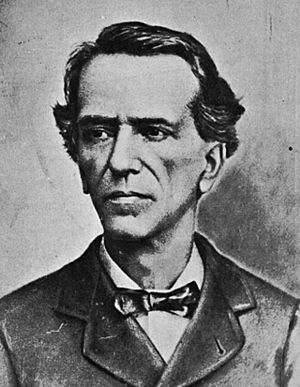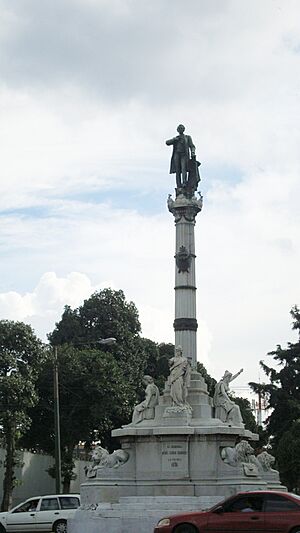Miguel García Granados facts for kids
Quick facts for kids
General of Division
Miguel Garcia Granados
|
|
|---|---|
 |
|
| President of Guatemala | |
| In office 30 June 1871 – 4 June 1873 |
|
| Deputy | Justo Rufino Barrios |
| Preceded by | Vicente Cerna y Cerna |
| Succeeded by | Justo Rufino Barrios |
| Personal details | |
| Born |
Miguel García Granados y Zavala
29 September 1809 Puerto de Santa María, Spain |
| Died | 8 September 1878 (aged 68) Guatemala City, Guatemala |
| Political party | Liberal |
| Children | María García Granados y Saborío |
Miguel García Granados y Zavala (born September 29, 1809 – died September 8, 1878) was an important Guatemalan politician and army general. He was born in Spain and later became the President of Guatemala from 1871 to 1873. He played a key role in the Liberal Revolution of 1871.
Contents
Early Life and Travels
Miguel García Granados was born in El Puerto de Santa María, Spain. When he was a young teenager, his family moved to Central America. His family was wealthy and had a military background.
When he was 23, Granados traveled a lot. He visited countries in South America and Europe. He also saw big cities like New York and Philadelphia in the United States. He finished his education in London, England. Miguel was the brother of the famous Guatemalan writer, María Josefa García Granados.
Political Career and Presidency
García Granados was known as a moderate liberal. This means he believed in freedom and progress but was also willing to work with others. He tried to get along with leaders like Rafael Carrera and Vicente Cerna.
However, García Granados supported a revolt against the government. He had to leave Guatemala for a while. Guatemalan liberals supported him during this time. When he returned, he became a leader of the revolution against President Cerna. He was even called its "philosopher."
After the liberals won, García Granados became the temporary president. This was in 1871, and he served until 1873. He wanted to make the government fair and lawful. In 1872, Guatemala invaded Honduras. During his time as president, he made important changes:
- He allowed freedom of the press, meaning people could write and publish what they thought.
- He asked the Jesuits (a religious group) to leave the country.
García Granados and his successor, Justo Rufino Barrios, supported many liberal changes. During his presidency, García Granados created the design for the Guatemalan flag. The flag used today is almost the same as his 1871 version.
He also cared a lot about education and the arts. In 1871, he invited an Italian musician named Pietro Visoni to Guatemala. Visoni became the director of the main military band. Later, Visoni started the Martial Symphony Band and the School of Substitutes. This was the first formal music school in Central America.
Retirement and Legacy
After his time as president, García Granados retired from public life. He spent his time writing articles for magazines and newspapers in Guatemala. He wrote about his experiences leading the liberal forces and being president. He also wrote an essay about money and two books of his memories.
In 1877, a Cuban writer named José Martí came to Guatemala. Martí taught at new schools there. He met Miguel García Granados' daughter, María García Granados y Saborío. María fell in love with Martí. After some time, María sadly passed away. Her father, Miguel García Granados, died shortly after her.
Death and Burial
Miguel García Granados died on September 8, 1878, when he was 69 years old. He was first buried in the old San Juan de Dios Cemetery. Later, in 1894, his remains were moved to a special monument built for him at the new General Cemetery.
Today, you can see his portrait on the 10 Quetzales bank note. This shows how important he was to Guatemala's history.
See also
- Rafael Carrera
- Vicente Cerna
- Justo Rufino Barrios
- María Josefa García Granados
- José Martí
- In Spanish: Miguel García Granados for kids


